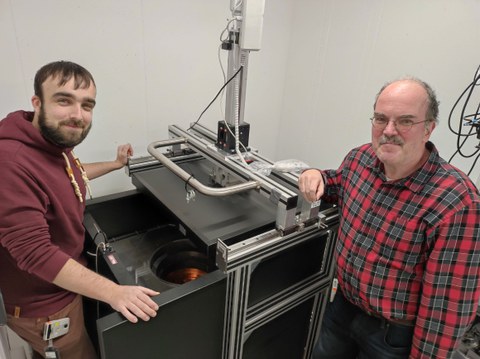28.02.2023
Dem Urknall auf der Spur: Der empfindlichste Detektor zur Messung von Radioaktivität steht nun in Dresden

v.r.: Prof. Kai Zuber (Professur für Kernphysik der TU Dresden & Wissenschaftlicher Leiter des Felsenkeller-Labors) und Steffen Turkat (Doktorand am Institut für Kern- und Teilchenphysik und wissenschaftlicher Mitarbeiter am Felsenkeller-Labor)
Im Untertagelabor „Felsenkeller“ in Dresden befindet sich seit kurzem der empfindlichste Aufbau zur Messung von Radioaktivität in Deutschland und einer der empfindlichsten Aufbauten der Welt. Mit dem neuen Detektor werden die Forschenden der TU Dresden und des Helmholtz-Zentrums Dresden-Rossendorf (HZDR) künftig an den spannendsten Fragen der Astrophysik zu dunkler Materie, Sternen oder dem Urknall auf internationalem Spitzenniveau arbeiten.
Was ist dunkle Materie? Was hat es mit Neutrinos auf sich? Wie funktionieren Sterne und was war eigentlich in den ersten Minuten nach dem Urknall im Universum los? Zur Beantwortung dieser Fragen benötigt man sehr empfindliche Detektoren und sehr viel Geschick. Nur in wenigen Laboren auf der Welt konnte man bisher solch sensitive Messungen durchführen. Seit kurzem gibt es jedoch auch in Deutschland einen derart empfindlichen Detektor, der den Forschenden zukünftig Antworten auf diese Fragen ermöglichen kann.
Nach langer Entwicklungsarbeit haben die Forschenden vom Institut für Kern- und Teilchenphysik (TU Dresden) und dem Institut für Strahlenphysik (HZDR) den Aufbau im Untertagelabor „Felsenkeller“ Dresden nun in Betrieb genommen. Sie können damit fortan Proben von Stoffen und Materialien mit einer Radioaktivität im Bereich von 100 Mikrobequerel analysieren, in anderen Worten, Proben mit 100 Millionen mal weniger Radioaktivität, als im menschlichen Körper vorhanden ist. Damit gehört der Messaufbau im Felsenkellerlabor zu der Weltspitze der sensitivsten Messgeräte für Radioaktivität.
„Wenn man seltene Prozesse und geringe Aktivitäten in der Physik untersuchen möchte, dann braucht man prinzipiell zwei Dinge: einerseits viel Geduld – denn die Prozesse finden ja nur selten statt – und andererseits eine Umgebung, die möglichst strahlungsarm ist, damit der Detektor nicht permanent von natürlichen Strahlungsquellen, wie sie z.B. in jedem Baumaterial vorhanden sind, gestört wird“, erklärt Steffen Turkat, TUD- Mitarbeiter im Felsenkeller-Labor.
So schützt die 45 Meter dicke Felsschicht im Stollen des ehemaligen Eislagers der Dresdner Felsenkeller-Brauerei den Detektor zwar vor einem Großteil der kosmischen Strahlung, jedoch nicht vor der natürlichen Radioaktivität aus der Umgebung. Daher mussten die Forschenden den Detektor zusätzlich mit einer ausgetüftelten Anordnung aus strahlungsarmen Betonwänden, großen Mengen an Blei und Kupfer sowie sogenannten Veto-Detektoren schützen. Nur so kann dieser hochempfindliche Aufbau funktionieren und Kernumwandlungen aus den wertvollen Proben auswerten.
„Ich freue mich besonders über die Vielzahl an ungeplanten Anfragen von interessierten Kolleg:innen weltweit, die den Detektor nun gerne nutzen würden. Bei diesen Anfragen geht es dann schnell mal um extrem wertvolle und seltene Proben, die wissenschaftlich äußerst spannend sind, die aber mit anderen Detektoren nicht analysiert werden können. So ein Detektor erzeugt somit automatisch neue Kollaborationen und Vernetzungen zu anderen faszinierenden Fachgebieten“, erläutert Steffen Turkat.
Prof. Kai Zuber von der TU Dresden ist der wissenschaftliche Leiter des Felsenkellerlabors und freut sich insbesondere darauf, seine eigenen anspruchsvollen Forschungsinteressen in der Physik jenseits des Standardmodells quasi vor der Haustür verfolgen zu können: „Ich interessiere mich vor allem für den doppelten Betazerfall und die Suche nach Prozessen, die die geladene Leptonenzahl verletzen würden. Aber auch für die Verbesserung der Halbwertszeiten von Radionukliden ist der Felsenkeller nun exzellent geeignet.“
Auch Prof. Daniel Bemmerer, Technischer Leiter des Felsenkellerlabors und Gruppenleiter für Nukleare Astrophysik am HZDR, ist begeistert von den neuen Möglichkeiten, die der Detektor bietet: „Wir können nun Aktivierungsmessungen für Kernfusions-Experimente bei Energien durchführen, die den eigentlichen Energien und Temperaturen in unserer Sonne wesentlich näherkommen, als es bisher möglich war. Dadurch wird auch eine neue Nutzungsmöglichkeit für den Felsenkeller-Beschleuniger geschaffen.“
Neben dem neuen Detektor ist in Deutschlands tiefstem Untertage-Physiklabor bereits seit 2019 ein Ionenbeschleuniger zur Untersuchung der wichtigsten Prozesse im Inneren der Sterne in Betrieb.
Der Detektor wurde aus Mitteln des Großgeräteprogramms der Deutschen Forschungsgemeinschaft beschafft.
Originalpublikation:
S. Turkat, D. Bemmerer, A. Boeltzig, A. R. Domula, J. Koch, T. Lossin, M. Osswald, K. Schmidt, K. Zuber, “A new ultra low-level HPGe activity counting setup in the Felsenkeller shallow-underground laboratory”, Astroparticle Physics, vol. 148, 102816 (2023).
DOI: 10.1016/j.astropartphys.2023.102816
Kontakt:
Prof. Kai Zuber
Institut für Kern- und Teilchenphysik
TU Dresden
Tel.: +49 351 463-42250
Prof. Daniel Bemmerer
Nukleare Astrophysik
HZDR
Tel.: +49 351 260 3581
Steffen Turkat
Institut für Kern- und Teilchenphysik
TU Dresden
Tel.: +49 351 463-32916
